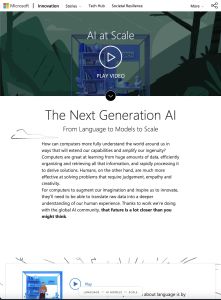Microsoft’s “ALT Story” on AI at Scale provides a multimedia overview, with links to press releases and technical documents. It gives the history of AI milestones in the last five years, such as object and speech recognition and language translation. It explains how a new class of powerful large-scale language models such as Microsoft’s Turing model is driving breakthroughs and accelerating AI innovation in its own products. Microsoft seeks to give customers access to state-of-the-art large-scale AI models, training optimization tools and supercomputing resources to accelerate their own innovation, what it calls “AI at Scale.”
Microsoft seeks to enable the next generation of AI, starting with human language.
Language is a fundamental aspect of what makes us human. Creating computers that are capable of augmenting human ingenuity requires a deep understanding of human language. But language is complex. As humans, it takes years to learn about the relationships between words and the importance of context. Meanwhile, language itself continues to evolve as new words appear and fresh nuances emerge across culture and societies.
Just like having access to diverse perspectives enriches our understanding of the world, training an AI model with the largest and most diverse data allows it to gain a richer understanding of language. So, Microsoft set out to enable the next generation of AI experiences by creating the largest, most powerful language model it could imagine.
As one form of machine learning, deep learning is developing rapidly.
The recent explosion of data provided by the internet, coupled with large amounts of fast computers facilitated by the cloud, has enabled the accelerated progress of deep learning. This subset of machine learning uses artificial neural networks...
Microsoft Corporation is an American multinational technology corporation that produces computer software, consumer electronics, personal computers, and related services.












Comment on this summary